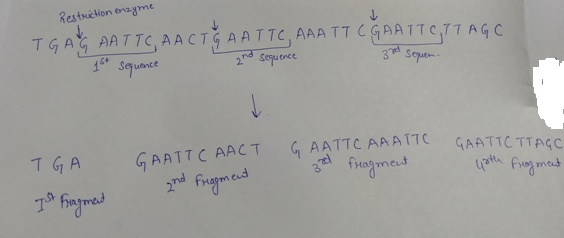
Concept explainers
If a restriction enzyme cuts between the G and the A whenever it encounters the sequence GAATTC, how many fragments will be produced when the enzyme is digested with DNA with the following sequence? TGAGAATTCAACTGAATTCAAATTCGAATTCTTAGC
- a. Two
- b. Three
- c. Four
- d. Five
Introduction:
Restriction enzymes are the enzymes that digest the higher molecular weight DNA in to smaller fragments. They are also known as restriction endonucleases.
Answer to Problem 1MCQ
Correct answer:
There are three sequences of GAATTC present on the DNA fragment and the fragments formed after the cleavage of the DNA are four in numbers. Therefore, option (c) is correct.
Explanation of Solution
Reason for correct statement:
Restriction endonucleases digest a double stranded DNA at specific sites. These specific sites are also called recognition site that present as palindrome. If the restriction enzyme given cuts between the G and A whenever it encounters the sequence GAATTC on the given DNA with the following sequence TGAGAATTCTGAATTCAAATTCGAATTCTTAGC, the cleaving of the DNA will be given as follows:

As shown, after the cleavage of the DNA by the help of the restriction enzyme, four fragments will be formed.
Option (c) is given as “Four”.
As, “the restriction enzyme recognizes three sequence on the given DNA, so it will make three cuts, that results in the production of the four DNA fragments,” is the right answer.
Hence, option (c) is correct.
Reasons for the incorrect statements:
Option (a), is given as “Two”.
The fragments of the DNA formed will be four after the action of the restriction enzyme. Hence, it is a wrong answer.
Option (b), is given as “Three”.
The DNA fragment formed after the cleavage will be four in numbers. Hence, it is a wrong answer.
Option (d), is given as “Five”.
For DNA fragments will be formed after the cutting action of the restriction enzyme at the given recognition site. Hence, it is a wrong answer.
Hence, options (a), (b), and (d), are incorrect.
Restriction enzymes are also known as molecular scissors that could cut double stranded DNA molecules at specific sites. It is an important tool that is used in the manipulation of DNA.
Want to see more full solutions like this?
Chapter 11 Solutions
BIOLOGY: CONCEPTS&INVEST. (LL)
Additional Science Textbook Solutions
Physics for Scientists and Engineers
Introductory Chemistry (6th Edition)
Laboratory Manual For Human Anatomy & Physiology
Microbiology Fundamentals: A Clinical Approach
Human Physiology: An Integrated Approach (8th Edition)
- What did the Cre-lox system used in the Kikuchi et al. 2010 heart regeneration experiment allow researchers to investigate? What was the purpose of the cmlc2 promoter? What is CreER and why was it used in this experiment? If constitutively active Cre was driven by the cmlc2 promoter, rather than an inducible CreER system, what color would you expect new cardiomyocytes in the regenerated area to be no matter what? Why?arrow_forwardWhat kind of organ size regulation is occurring when you graft multiple organs into a mouse and the graft weight stays the same?arrow_forwardWhat is the concept "calories consumed must equal calories burned" in regrads to nutrition?arrow_forward
- You intend to insert patched dominant negative DNA into the left half of the neural tube of a chick. 1) Which side of the neural tube would you put the positive electrode to ensure that the DNA ends up on the left side? 2) What would be the internal (within the embryo) control for this experiment? 3) How can you be sure that the electroporation method itself is not impacting the embryo? 4) What would you do to ensure that the electroporation is working? How can you tell?arrow_forwardDescribe a method to document the diffusion path and gradient of Sonic Hedgehog through the chicken embryo. If modifying the protein, what is one thing you have to consider in regards to maintaining the protein’s function?arrow_forwardThe following table is from Kumar et. al. Highly Selective Dopamine D3 Receptor (DR) Antagonists and Partial Agonists Based on Eticlopride and the D3R Crystal Structure: New Leads for Opioid Dependence Treatment. J. Med Chem 2016.arrow_forward
- The following figure is from Caterina et al. The capsaicin receptor: a heat activated ion channel in the pain pathway. Nature, 1997. Black boxes indicate capsaicin, white circles indicate resinferatoxin. You are a chef in a fancy new science-themed restaurant. You have a recipe that calls for 1 teaspoon of resinferatoxin, but you feel uncomfortable serving foods with "toxins" in them. How much capsaicin could you substitute instead?arrow_forwardWhat protein is necessary for packaging acetylcholine into synaptic vesicles?arrow_forward1. Match each vocabulary term to its best descriptor A. affinity B. efficacy C. inert D. mimic E. how drugs move through body F. how drugs bind Kd Bmax Agonist Antagonist Pharmacokinetics Pharmacodynamicsarrow_forward
- 50 mg dose of a drug is given orally to a patient. The bioavailability of the drug is 0.2. What is the volume of distribution of the drug if the plasma concentration is 1 mg/L? Be sure to provide units.arrow_forwardDetermine Kd and Bmax from the following Scatchard plot. Make sure to include units.arrow_forwardChoose a catecholamine neurotransmitter and describe/draw the components of the synapse important for its signaling including synthesis, packaging into vesicles, receptors, transporters/degradative enzymes. Describe 2 drugs that can act on this system.arrow_forward
 Concepts of BiologyBiologyISBN:9781938168116Author:Samantha Fowler, Rebecca Roush, James WisePublisher:OpenStax College
Concepts of BiologyBiologyISBN:9781938168116Author:Samantha Fowler, Rebecca Roush, James WisePublisher:OpenStax College
 Human Heredity: Principles and Issues (MindTap Co...BiologyISBN:9781305251052Author:Michael CummingsPublisher:Cengage Learning
Human Heredity: Principles and Issues (MindTap Co...BiologyISBN:9781305251052Author:Michael CummingsPublisher:Cengage Learning Biology: The Dynamic Science (MindTap Course List)BiologyISBN:9781305389892Author:Peter J. Russell, Paul E. Hertz, Beverly McMillanPublisher:Cengage Learning
Biology: The Dynamic Science (MindTap Course List)BiologyISBN:9781305389892Author:Peter J. Russell, Paul E. Hertz, Beverly McMillanPublisher:Cengage Learning Human Biology (MindTap Course List)BiologyISBN:9781305112100Author:Cecie Starr, Beverly McMillanPublisher:Cengage Learning
Human Biology (MindTap Course List)BiologyISBN:9781305112100Author:Cecie Starr, Beverly McMillanPublisher:Cengage Learning Biology Today and Tomorrow without Physiology (Mi...BiologyISBN:9781305117396Author:Cecie Starr, Christine Evers, Lisa StarrPublisher:Cengage Learning
Biology Today and Tomorrow without Physiology (Mi...BiologyISBN:9781305117396Author:Cecie Starr, Christine Evers, Lisa StarrPublisher:Cengage Learning





